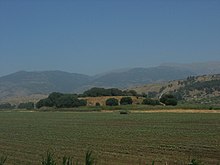| תל אנפה | |
 Tel Anafa, from the south Tel Anafa, from the south | |
 | |
| Location | Israel |
|---|---|
| Coordinates | 33°10′38″N 35°38′41″E / 33.177164°N 35.644694°E / 33.177164; 35.644694 |
| Area | 11 dunams |
| History | |
| Abandoned |
|
| Periods | Middle and Late Bronze Age, Iron Age, Hellenistic period, early Roman period |
Tel Anafa (Hebrew: תל אנפה, lit. "Egret hill" Arabic: تل الأخضر, romanized: Tel el-Hader, lit. "The green hill") is an archaeological site and nature reserve in the Upper Galilee, Israel.
Occupational history
Tel Anafa was inhabited from the Early Bronze Age through the early Roman period, but most of the significant archaeological remains are from the Hellenistic period.
The site was resettled in the late Hellenistic period, in the last quarter of the second century BCE, during which a large building with a central courtyard was constructed. It was abandoned around 80–75 BCE but resettled in the last decade of the same century, during the tetrarchy of Herod Philip. This early Roman phase continued until the mid-1st century CE, when the site was abandoned once more.
The land on which it is situated has since 1984 been part of an 11-dunam nature reserve.
Small findings
Coins and amphora handles from the late 4th to the 2nd century were unearthed.
Cooking pans and lids imported from Italy were found in late Hellenistic levels, dating from c. 100–80 BCE. These items are an early example for commercial exchange between Italy and the Levant before the Roman conquest of the region.
See also
References
- Bar'am, Aviva. "A monumental north". JPost.com » Israel Travel Guide. Archived from the original on 2009-01-06.
- "Tel Anafa". Kelsey Museum of Archaeology.
- "Ancient Tel Anafa". The History of the Ancient Near East Electronic Compendium.
- ^ Berlin, Andrea M. (1993). "Italian Cooking Vessels and Cuisine from Tel Anafa". Israel Exploration Journal. 43 (1): 35. ISSN 0021-2059.
- ^ Ancient Tel Anafa
- "List of National Parks and Nature Reserves" (PDF) (in Hebrew). Israel Nature and Parks Authority. Archived from the original (PDF) on 2009-10-07. Retrieved 2010-10-10.
Further reading
- Sharon, Herbert (1993). E. Stern (ed.). New Encyclopedia of Archaeological Excavations in the Holy Land. Vol. 1. Jerusalem: Israel Exploration Society and Carta. pp. 58–61.
- Sharon Herbert; Donald T. Ariel (1994). Tel Anafa I: final report on ten years of excavation at a Hellenistic and Roman settlement in northern Israel. Kelsey Museum of Archaeology at the University of Michigan. pp. 19–22. Retrieved 10 October 2010..
- Sharon C. Herbert, Tel Anafa I, i and ii, Final Report on Ten Years of Excavation at a Hellenistic and Roman Settlement in Northern Israel (Ann Arbor: Kelsey Museum 1994) (Journal of Roman Archaeology, Suppl. 10, I, i and ii; Kelsey Museum Fieldwork Series); Andrea Berlin and Kathleen Warner Slane, Tel Anafa II, i, The Hellenistic and Roman Pottery (Ann Arbor: Kelsey Museum 1997) (Journal of Roman Archaeology, Suppl. 10, II, i; Kelsey Museum Fieldwork Series).
- Saul S. Weinberg, Tel Anafa : the Hellenistic town (Jerusalem : National Museum 1970)
| Nature reserves of Israel | |||||||||||
|---|---|---|---|---|---|---|---|---|---|---|---|
| Jerusalem District | |||||||||||
| Northern District |
| ||||||||||
| Haifa District |
| ||||||||||
| Central District | |||||||||||
| Southern District |
| ||||||||||
| Judea and Samaria Area | |||||||||||
| Located in the Israeli-occupied Golan Heights and West Bank. | |||||||||||